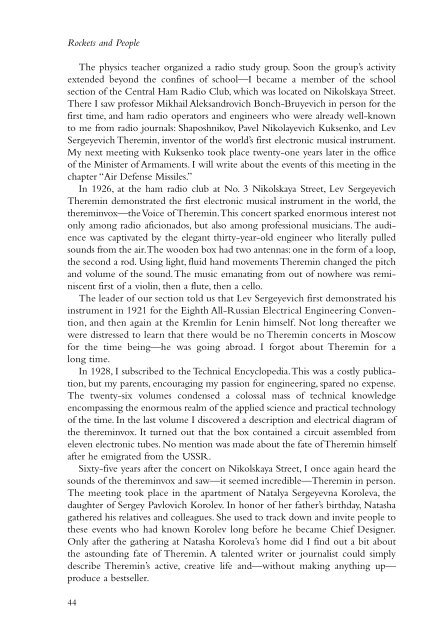to open next chapter. - NASA's History Office
to open next chapter. - NASA's History Office
to open next chapter. - NASA's History Office
Create successful ePaper yourself
Turn your PDF publications into a flip-book with our unique Google optimized e-Paper software.
Rockets and People<br />
The physics teacher organized a radio study group. Soon the group’s activity<br />
extended beyond the confines of school—I became a member of the school<br />
section of the Central Ham Radio Club, which was located on Nikolskaya Street.<br />
There I saw professor Mikhail Aleksandrovich Bonch-Bruyevich in person for the<br />
first time, and ham radio opera<strong>to</strong>rs and engineers who were already well-known<br />
<strong>to</strong> me from radio journals: Shaposhnikov, Pavel Nikolayevich Kuksenko, and Lev<br />
Sergeyevich Theremin, inven<strong>to</strong>r of the world’s first electronic musical instrument.<br />
My <strong>next</strong> meeting with Kuksenko <strong>to</strong>ok place twenty-one years later in the office<br />
of the Minister of Armaments. I will write about the events of this meeting in the<br />
<strong>chapter</strong> “Air Defense Missiles.”<br />
In 1926, at the ham radio club at No. 3 Nikolskaya Street, Lev Sergeyevich<br />
Theremin demonstrated the first electronic musical instrument in the world, the<br />
thereminvox—the Voice of Theremin.This concert sparked enormous interest not<br />
only among radio aficionados, but also among professional musicians. The audience<br />
was captivated by the elegant thirty-year-old engineer who literally pulled<br />
sounds from the air.The wooden box had two antennas: one in the form of a loop,<br />
the second a rod. Using light, fluid hand movements Theremin changed the pitch<br />
and volume of the sound.The music emanating from out of nowhere was reminiscent<br />
first of a violin, then a flute, then a cello.<br />
The leader of our section <strong>to</strong>ld us that Lev Sergeyevich first demonstrated his<br />
instrument in 1921 for the Eighth All-Russian Electrical Engineering Convention,<br />
and then again at the Kremlin for Lenin himself. Not long thereafter we<br />
were distressed <strong>to</strong> learn that there would be no Theremin concerts in Moscow<br />
for the time being—he was going abroad. I forgot about Theremin for a<br />
long time.<br />
In 1928, I subscribed <strong>to</strong> the Technical Encyclopedia.This was a costly publication,<br />
but my parents, encouraging my passion for engineering, spared no expense.<br />
The twenty-six volumes condensed a colossal mass of technical knowledge<br />
encompassing the enormous realm of the applied science and practical technology<br />
of the time. In the last volume I discovered a description and electrical diagram of<br />
the thereminvox. It turned out that the box contained a circuit assembled from<br />
eleven electronic tubes. No mention was made about the fate of Theremin himself<br />
after he emigrated from the USSR.<br />
Sixty-five years after the concert on Nikolskaya Street, I once again heard the<br />
sounds of the thereminvox and saw—it seemed incredible—Theremin in person.<br />
The meeting <strong>to</strong>ok place in the apartment of Natalya Sergeyevna Koroleva, the<br />
daughter of Sergey Pavlovich Korolev. In honor of her father’s birthday, Natasha<br />
gathered his relatives and colleagues. She used <strong>to</strong> track down and invite people <strong>to</strong><br />
these events who had known Korolev long before he became Chief Designer.<br />
Only after the gathering at Natasha Koroleva’s home did I find out a bit about<br />
the as<strong>to</strong>unding fate of Theremin. A talented writer or journalist could simply<br />
describe Theremin’s active, creative life and—without making anything up—<br />
produce a bestseller.<br />
44
















